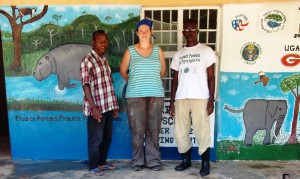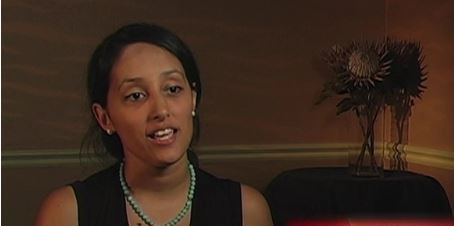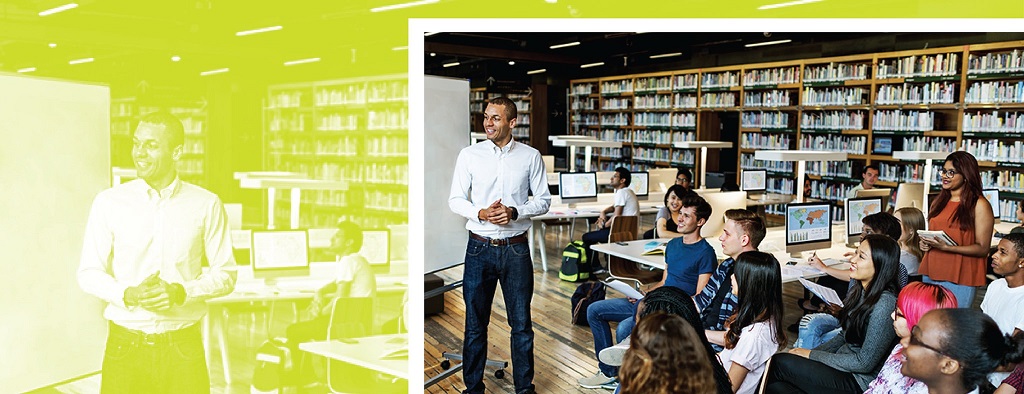
(From left to right) Joseph Flomo (The Environmental Foundation for Africa), April Conway 2010-2011, Sierra Leone, and Mohamed Konneh (Across the River: Trans-boundary Peace Park) taking a break from painting the environmental mural on a market wall in Bandajuma
I first arrived in Sierra Leone in 2008 and spent nine months on a remote river island called Tiwai to study the endangered and enigmatic pygmy hippopotamus for my dissertation research. As I continued my research and learned more about the Mende people’s lives, I realized how important it is to incorporate the needs of people living near protected areas into conservation. I returned to the United States determined to find a way to continue to learn more about the pygmy hippo while also helping those who I lived and worked beside.
My Fulbright experience first began when a colleague of mine, who had received a Fulbright grant to study in Uganda, contacted me, and told me about the possibility of conducting research through the program. I immediately began my application. Unbelievably, in August 2010, I was on a flight to Sierra Leone as a Fulbright Study/Research grant recipient, this time armed with resources and knowledge to make the most of my ten-month stay.
Besides my Fulbright research, in collaboration with The Environmental Foundation for Africa and the Across the River: Trans-boundary Peace Park program, I conducted environmental education programs in schools on endangered species and conservation. Many of these children (and their parents) had never met a foreigner and were eager to learn why I’d travelled so many miles from my home and family, creating an opportunity for both sides to learn.
The Fulbright Program also provided the opportunity to team up with the staff at the U.S. Embassy, who understood my interest in connecting with locals. I found pictures to be an especially useful tool in areas where the majority of residents are illiterate, and this led me to prepare a small grant proposal for paint and supplies. Joined by a Peace Corps volunteer, local school children, and community volunteers, I painted murals that depicted conservation of pygmy hippos and their habitats. Residents enjoyed identifying all the elements of the mural and were proud of the artwork that they had contributed to their community.

(Left to right) Porotur Barri, April Conway, 2010-2011, Sierra Leone, Mohamed Konneh (Across the River: Trans-boundary Peace Park), Joseph Flomo (The Environmental Foundation for Africa), Chrissy Corrigan (Peace Corps) and Kenewa Koroma take a break from painting a mural on the Potoru Court Meeting structure
Each mural would take a few days to complete, and during this time, people would ask questions about what we were doing. This curiosity generated many conversations about conservation issues. Although my dissertation research focused on the biological aspects of an endangered species, it is the memories of people I met that will remain with me long after my papers are published and I have graduated. Receiving a Fulbright grant allowed me to interact with thousands of people, and make friends and colleagues that I will remember forever.
My advice to future applicants is to get your host affiliations secured early –communication is sometimes slow!
Additionally, I recommend asking people unfamiliar with your research to edit your essays; they can point out any use of unnecessary technical jargon or unclear passages.
Remember, while you may be in the country to conduct research, take time out to interact with diverse groups of people—they are always your best resource for learning the local language and culture.
Finally, have fun! This is your time to do something you are passionate about. Your Fulbright year is sure to be one the best experiences of your life, so enjoy!
Have questions for April? She can be contacted as a Fulbright Alumni Ambassador at AConway.AlumniAmbassador@fulbrightmail.org.



No Comments